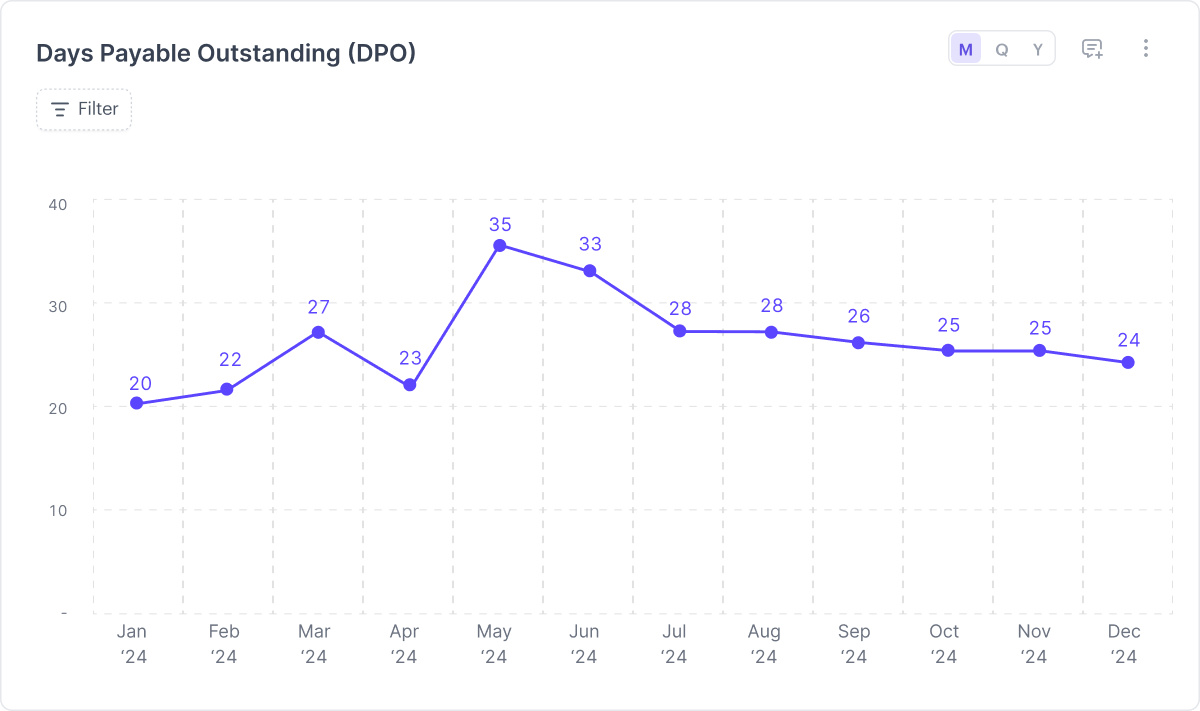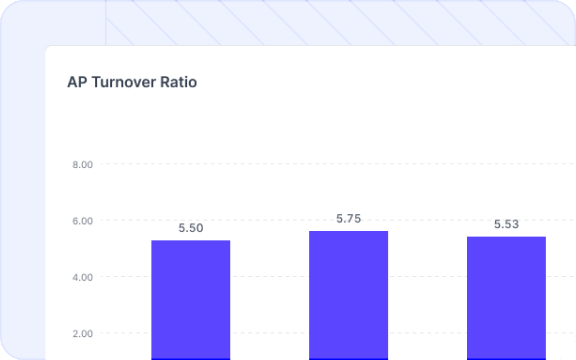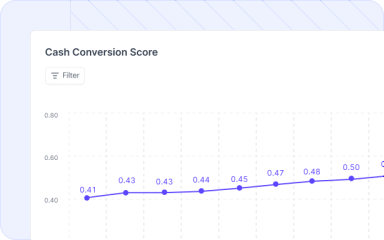Read TL;DR
- Days payable outstanding (DPO) measures how long it takes your company to pay its suppliers after receiving an invoice.
- DPO is a key metric for measuring the efficiency of your company's cash flow management.
- A higher DPO shows you keep cash longer, but it may also indicate delays in vendor payments. Low DPO signals efficiency but may strain liquidity.
- Balancing DPO helps companies manage working capital, fund growth, and maintain operational stability.
Smart finance leaders and teams always have a strategic toolbox on hand that they can pull from when business gets tough or the market becomes unpredictable. Vendor expenses are often one of the first things they’ll look at during these times, and optimizing their days payable outstanding is a useful tool for getting through them.
Days payable outstanding (DPO), also known as days creditors outstanding, measures how long a company takes to pay its vendors and suppliers.
DPO is an important metric for any business because it helps finance leaders determine how much cash is available for growth, product development, or operations. It can also be leveraged in ways that directly impact working capital.
In this article, we’ll take a deep dive into DPO explaining how to calculate and interpret it and how optimizing vendor terms can improve cash flow in your business.
Table of Contents
What is days payable outstanding (DPO)?
At a high level, DPO helps you understand how you're managing your working capital and vendor relationships. This can have pretty important implications for a company, particularly in terms of cash flow.
However, those impacts differ based on a variety of factors, including whether or not you carry inventory and when your revenue is recognized relative to when you have to pay your vendors. Let’s take a closer look here, at how DPO can impact cash flow for different types of businesses and other reasons it’s an important metric to track.
Why DPO matters
Working capital efficiency
Cash inflow delays can strain your working capital. By strategically managing outflows, you can better align expenses with revenue and optimize your DPO to maintain operational liquidity. For instance, if your customer payment terms average 30 days but your DPO is 60, you're effectively using supplier credit.
DPO can be particularly important for SaaS businesses where customer acquisition costs (CAC) are high, and revenue from new deals takes time to materialize. A good DPO strategy syncs payments with incoming revenue to help finance teams avoid shortfalls or overdrafts.
Cash conversion cycle impact
A longer DPO helps to shorten the cash conversion cycle (CCC), which measures how long it takes a business to convert its investments into cash.
The impact of DPO on the CCC is really more important for inventory-based businesses than it is for SaaS and service-based businesses. This is because the CCC focuses on the conversion of inventory to cash. And since SaaS and service-based businesses don’t carry inventory, the metric has little meaning.
However, the impact of a longer DPO for an inventory-based business can be powerful. For example, retailers often have a lot of cash tied up in their inventories. The more of that inventory they can sell before they have to pay their suppliers, the more working capital they will have to invest in additional inventory, staff up for holiday season sales, and continue to pay the rent and other fixed operational expenses during slower periods.
Risk mitigation
SaaS companies are particularly prone to cash flow issues due to spikes in churn, enterprise contract delays, seasonal fluctuations, or late payments. A flexible DPO strategy is beneficial during lean periods, as it ensures continuity and protects supplier relationships. This can help reduce the need to rely on emergency credit or cut down operations if payments or renewals are delayed.
Inventory-based businesses are vulnerable to seasonal fluctuations in sales and economic downturns, losses due to inventory obsolescence and theft, and supply chain issues. Optimizing their DPO can help preserve cash to weather these difficulties and invest in other risk mitigation initiatives, like better inventory management systems and diversifying their suppliers.
Investment opportunity
Optimizing DPO allows businesses to keep cash in the business longer—cash that SaaS companies can invest in growth initiatives, such as product innovation, geographic expansion, or other high-ROI areas.
Instead of raising equity or debt to scale, founders can negotiate longer payment windows to support growth. However, SaaS leaders must maintain clear communication with vendors to ensure feasibility.
The relative impact of this type of “short-term financing” for creating opportunity is magnified for inventory-based businesses where negotiating longer payment terms of 90-120 is not uncommon.
Operational process benchmark
DPO shows the maturity of your procurement and accounts payable processes. Manual reconciliation or approval delays can cause DPO to stagnate or fluctuate. An improving DPO indicates that your finance team is streamlining invoice processing, negotiating better terms, or using automation.
Inventory-based business can leverage this to build trust with new suppliers. Similarly, for SaaS businesses, a low DPO can signal strong financial leadership to potential investors.
DPO, when combined with other key metrics like days sales outstanding (DSO), shows your negotiation capabilities and operational efficiency. Investors often look for high or improving DPO, which indicates strong financial management and vendor relationships.
Learn more about SaaS metrics here
How to calculate DPO?
Approaches to calculating DPO vary by industry based on cost structures and cash flow. In this section, we provide two basic approaches, the standard DPO formula and an alternative approach that can be used instead of or alongside the
The standard DPO formula
The standard formula below is what most inventory-based businesses, such as manufacturing and retail, use to calculate their DPO:

This formula can be used to calculate DPO for any period. You would use average accounts payable (AP) for the period and divide it by the cost of goods sold (COGS) during the same period and multiply the result by the number of days in the period.
Here’s how to calculate the average AP for the period:

Alternative approach: Purchase-based calculation
The standard DPO formula works well for most inventory-based businesses but it can be problematic for service-based businesses and SaaS companies. This is because the COGS for these and other “inventory-light” businesses doesn’t capture the full range of expenses reflected in their accounts payable.
Unlike businesses where inventory comprises a significant amount of their accounts payable, for service-based businesses, accounts payable includes expenses for intangible things like subcontractor fees, travel expenses, and software licenses. All of these are tracked in accounts payable but may not be treated as part of their COGS.
Similarly, the COGS for SaaS businesses includes expenses related specifically to the delivery of their services but misses significant operating expenses, such as sales and marketing expenses.
Using a purchased-based approach solves these problems by basing the DPO calculation on purchase activity to provide a more accurate representation of DPO.
Here’s how to calculate it:
Step 1. Calculate the average AP for the period
Note that the formula is the same one you would use with the standard DPO formula above:

Step 2. Use the average AP to calculate the AP turnover ratio
In the formula for accounts payable turnover ratio, the net credit purchases includes all purchases made on credit during the period.

Step 3. Use the AP turnover ratio to calculate your DPO

An example using both methods
In this example, we’ll calculate the DPO for a SaaS company using each method, starting with the standard DPO formula.
Here’s the data we have to work with for Q1 of 2025 (90 days):
- Beginning AP: $120,000
- Ending AP: $180,000
- COGS (aka cost of revenue): $450,000
- Total credit purchases: $600,000
First, we’ll calculate the average AP:

Plugging the average AP into the standard DPO formula, we get a DPO of 30 days:

Now, using the purchase-based DPO method, we’ll start by calculating the AP turnover, using our average AP value from above:

This gives us an AP turnover of 4, which we can then use to calculate the DPO with the purchase-based formula:

Let’s take a closer look at the difference in these results:
- DPO based on cost of revenue is 30 days: Shows how long it takes to pay for expenses related to delivery of services to its customers, which for a SaaS company, includes hosting costs, third-party software licenses, customer success expenses, and direct support costs.
- Purchase-based DPO is 22.5 days: Shows how long it takes to pay for all purchases made on credit, which for a SaaS company often includes significant marketing expenses that don't fall under COGS.
For SaaS companies, using a purchase-based method provides a clearer, more accurate picture of how quickly they’re paying their vendors, which is important for managing cash flow and vendor relationships.
What does your DPO mean?
Determining an ideal DPO is complex, as it depends on factors like market conditions and industry specifics.
Understanding low DPO
A low DPO means your company pays suppliers faster than the industry standard of 30-60 days. On the surface, a low DPO suggests strong cash management and good will. However, at a granular level, it may also indicate limited negotiation with vendors or missed opportunities to optimize cash flow.
Early payment discounts may seem beneficial, but holding cash longer can have its advantages, too, especially for SaaS businesses as it can lead to faster cash burn and reduce working capital which is critical for growth.
Traditional, inventory-based businesses have different strategies for improving DPO, such as leveraging their purchase power to negotiate more favorable payment terms. SaaS and service-based businesses can leverage their history of on-time payments and growing spend.
Considering the implications DPO has on cash flow, it makes a lot of sense for most businesses to pay invoices when they’re due and not before.
Understanding high DPO
A high DPO of 60 days or more can reflect smart cash flow management, like holding cash to fuel growth or strong vendor negotiations. However, it can also signal cash flow issues, where payments are delayed out of necessity.
It's important to distinguish between strategic optimization and reactive delays to use DPO effectively. A high DPO can strain supplier relationships and disrupt operations if mismanaged. Vendors may grow frustrated with delayed payments and may consider imposing late fees or tighter payment terms.
Investors may consider aggressive DPO strategies as signals of financial distress, so you must balance cash preservation with vendor goodwill. Using DPO strategically lets you reinvest cash quickly during rapid growth phases, seasonal dips, and high-ROI opportunities.
Understanding DPO and using it strategically is easier when you compare it to other cash flow metrics:
- DPO vs. Days sales outstanding (DSO): DSO shows how quickly customers pay the business, while DPO tracks how long the business takes to pay suppliers. The gap impacts your working capital. Having a higher DPO than DSO improves liquidity. Businesses can use this as an opportunity to use supplier credit to reinvest in growth.
- DPO vs. Net burn rate: Net burn rate is a metric startups use to track how quickly they’re “burning” through their cash each month. This is important because SaaS businesses have high upfront costs related to product development before the revenue starts coming in. By optimizing DPO and delaying payments to suppliers, they can reduce cash burn without cutting costs. Extending vendor payment terms provides a cash runway for reaching targets without opting for external funding.
- DPO vs. Cash Conversion Cycle (CCC): This is a metric used by companies that carry inventory. It measures how quickly a company turns investments into cash. Given SaaS businesses don’t carry inventory, the CCC has little meaning for them. To understand how efficiently they’re using the funding they receive from investors, they use the cash conversation score instead, which doesn’t rely on DPO.
- DPO vs. Current ratio and Quick ratio: Current ratio and quick ratio measure a company's liquidity. A high DPO can improve cash flow by letting companies hold cash longer, but it also raises accounts payable, which can lower liquidity ratios like the current and quick ratios. It makes liquidity seem weaker on paper, even as cash management improves. Business leaders need to break this down for investors.
- DPO vs. Accounts payable turnover: AP turnover and DPO are inverse metrics for payment practices. AP turnover shows how often a company pays suppliers annually, while DPO tracks the average days per payment. Higher AP turnover means lower DPO and faster payments, while lower AP turnover means higher DPO and slower payments. DPO helps company leaders with cash flow management, while AP Turnover helps with peer benchmarking. DPO vs. other cash flow metrics
- DPO vs. Free cash flow metrics: Free cash flow (FCF) is the cash left after covering operating expenses and capital expenditures. It shows a company’s ability to invest, pay debt, or distribute dividends. DPO measures payment efficiency, while FCF tracks liquidity and financial health. Together, these metrics offer insights into a company's payment management and cash generation.
- DPO vs. Operating cash flow ratio: The operating cash flow ratio evaluates a company's ability to cover short-term obligations with cash from operations. Shifting the timing of cash outflows temporarily boosts operating cash flow by improving liquidity on paper without impacting profitability. While a higher ratio may suggest better cash flow, leaders must keep a check that the improvement comes from stronger operations, not just delayed payments.
Optimize your cash flow by tracking DPO with Drivetrain
DPO unlocks working capital by balancing liquidity with strong vendor relationships. Manually tracking DPO across vendors and payment schedules is time-consuming and error-prone.
Modern FP&A tools like Drivetrain use automation to pull real-time data from financial systems, calculate DPO instantly, and provide insights through dashboards. A streamlined process reduces errors and helps SaaS finance teams make informed decisions to improve cash flow.
Drivetrain simplifies DPO tracking and optimization for businesses with real-time calculations, automated data syncing, and customizable dashboards. It helps forecast cash flow, simulate scenarios for improving vendor management, set DPO targets, and benchmark against industry standards. By eliminating manual tasks, Drivetrain gives finance teams insights to optimize payment cycles and drive growth.
See how Drivetrain simplifies DPO management to help your business grow.
FAQs
Inventory-based businesses calculate DPO by dividing the average accounts payable by the cost of revenue and then multiplying the result by the number of days in the given period:

An alternate method for SaaS companies with irregular purchasing patterns and service-based businesses is to calculate DPO based on actual purchase activity:

For this method, you have to first calculate your average AP, then use that value to calculate your AP turnover ratio. Dividing the total number of days in the period by the AP turnover ratio gives you the DPO.
For businesses with inventory, the standard DPO is more useful. For SaaS businesses and service-based businesses, the purchase-based DPO is better.
AP turnover rate and days payable outstanding (DPO) measure the same thing from opposite angles. AP turnover tells you how many times per year you pay off your vendor bills (like 12 times = once a month). DPO tells you how many days it takes to pay a typical bill (like 30 days).
The math connection: DPO = 365 ÷ AP turnover. So if your AP turnover is 12, your DPO is about 30 days.
Most people find DPO easier to understand because it is direct and simple. “We pay bills in 45 days” is obviously more intuitive than “we turn over payables eight times per year.”
Companies can improve DPO by negotiating extended payment terms based on their payment history. Avoid early payments by scheduling invoice payments for the last day of the term with automated accounts payable. Consolidate vendors to negotiate for better payment terms. Track DPO to measure the effectiveness of your accounts payable processes.
A high DPO helps companies preserve cash for growth. However, excessively high DPO can harm vendor relationships or disrupt operations.










.svg)

